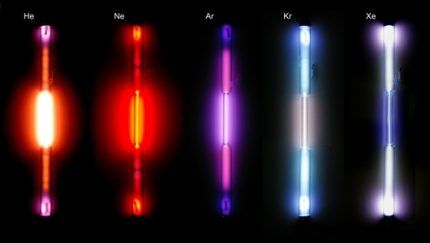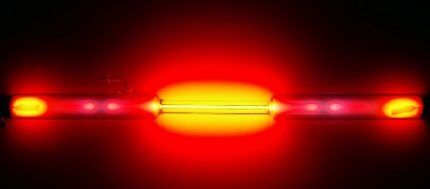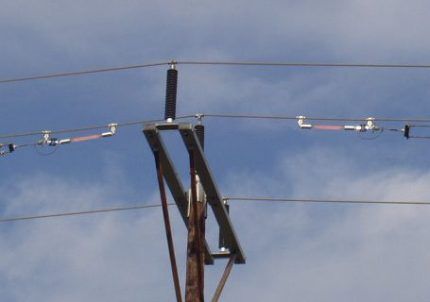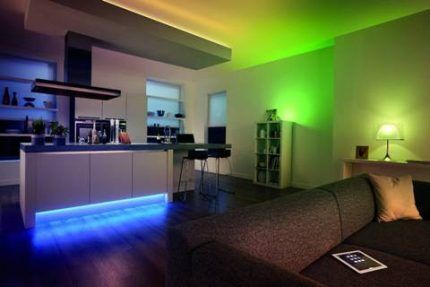How neon lamps work and how to choose the best option for your home
Creating color effects in lighting systems has become possible using light sources such as neon lamps, which are gas-discharge lamps and can be filled not only with neon, but also with other gases.
They are actively used by designers, advertisers and decorators; in addition, they are valued by lighting specialists for their reliability and long service life.
In this material we will understand the design features of neon lighting sources, talk about their advantages and disadvantages, as well as how to decorate the interior with their help.
The content of the article:
Design and principle of operation
Externally, the lamp resembles an ordinary one fluorescent device - this is a glass tube, but filled not with argon with a drop of mercury, but with neon or other inert gas. The choice of gas affects the color of the glow, and the process of pumping it into the tube occurs under low pressure.
The tube shape is the most convenient design, working according to the following scheme. Electrodes are connected on both sides, to which voltage is then applied. Under the influence of voltage, gas atoms leave the negative electrodes and acquire a positive charge.
Positively charged atoms move towards the minus pole-electrode, and negatively charged electrons move towards the positive one. Charged gas atoms and electrons separated from them are called plasma, and they form the electrical circuit of a neon tube.

If you look closely at the different types of neon bulbs, you will notice the difference: some of them have an even, calm glow, others shine as brightly as possible. In the second case, mercury vapor is placed inside the tube along with an inert gas. Under the influence of electric current, they begin to emit ultraviolet radiation - hence the unusual, “magical” lighting.
Lamps filled with inert gas operate equally well on alternating and direct current. However, the second option will look inferior, since the illumination area will be concentrated around one electrode. For this reason, alternating current is used to connect devices, and the voltage value must be high - up to 15,000 V.

To increase the standard voltage to the required value, a transformer is used. It has been experimentally verified that a voltage of less than 1000 V does not cause a discharge inside the tube, therefore it will not glow.
A mandatory stage in the manufacture of neon lamps is lengthy testing. To do this, devices are connected to voltage for 12 hours or more, after which deficiencies are identified. During this period, mercury vapor is mixed with the gas and distributed evenly inside the tube, and the voltage stabilizes.
Color variety of gas light lamps
The color range of neon devices is really wide. The shades depend on the selected gas, on the composition of the substance applied to the glass and on the gas additive to the noble filling of the tube. They can change intensity due to current instability. When separated, the electrons of noble gas atoms release energy, which determines the wavelength of light, and therefore the color.

If you use pure inert gases in the tubes, they will produce the following colors:
- helium – pink;
- krypton – green;
- argon – lilac or blue.
Other colors are also available. To do this, mix various gases, change their proportions, and apply phosphors on the inside of the glass. For example, using krypton as phosphor-coated tubes, you can obtain a wide range of yellow shades.
The density and frequency of the electrical current can also affect the color change. If we take a neon lamp as an example, then when the current density decreases, the glow will become orange, and when it increases, it will move into the blue segment of the glow spectrum.

For the effect of ultraviolet lamps to be present in gas discharge devices, they are filled with xenon or krypton.Sometimes they use mixtures of them in various proportions and a mix with argon.
There is an article on our website where we talked in detail about ultraviolet lamps for home use. Read more - read Further.
Advantages and disadvantages of lamps
Gas discharge lamps quickly occupied their niche and are not going to leave it due to their positive qualities. The advantages relate to both the abundance of applications and the technical characteristics of the devices. If we analyze all aspects from the point of view of users and specialists, we can highlight the following advantageous qualities.
Now let’s turn to the disadvantages that are also present and force one to abandon gas-discharge lamps, for example, in everyday life.
Here are some of them:
- the power of neon devices is much lower than that of similar LED devices - 10 W/m;
- fragility of the tube material – glass; if one lamp is broken, the entire circuit will go out;
- it is necessary to constantly ensure that gas harmful to health, if it is part of the filler, does not escape; special disposal is intended for lamps;
- installation requires special care and knowledge; you can connect the circuit elements incorrectly or accidentally break the glass.
And most importantly, colored lighting is more of a decorative nature and is not the basis of the lighting system. It is good for highlighting individual zones or creating attractive compositions, but is inappropriate in “working” areas - in offices, in the kitchen, in the workshop, in the nursery.
Application of neon light sources
It is a mistake to think that neon devices are only elements of decorative design and advertising signs. In fact, they have been used for over a century, in a wide variety of applications.
For example, before the advent of LEDs, neon light sources were used as voltage indicators of a standard 220 V network.

Large lamps are equipped standard bases E14 and E27 and are intended for cartridges that are also used in everyday life. So that the device can illuminate and operate from a 220 V network, a resistor is built into the housing.
In the last century, similar lamps were used as night lights, but were sold together with lamps. Now production in Russia is closed, but the Chinese continue to produce similar products.

A few more areas of application of neon devices:
- release of indicator probes to detect alternating voltage in phase;
- use in strobe;
- as a threshold or active element in generating devices;
- as a protective element in telephone networks.
A familiar use to modern man is the advertising industry. The streets of megacities shimmer with all the colors of the rainbow; letters, logos, outlines, lights and other eye-catching advertising elements are made from glass tubes with a bright glow.
An excellent example of the use of neon lighting is American Las Vegas and other places associated with the entertainment industry. Nightclubs, casinos, theaters, cafes and hotels are strewn with colorful lights.
Interior Design Tips
In residential premises, neon lights are rarely and reluctantly used. Perhaps this is due to the inappropriateness of multi-colored lighting in small apartments, which are still the basis of the residential sector of cities, especially provincial ones.
However, in new-plan cottages and apartments with high ceilings, neon lighting is being used more and more actively.

Recommendations from designers and decorators may be of interest to anyone who wants to change the atmosphere, refresh the interior, make repairs, or simply experiment with neon lighting. To do this, you need to purchase lamps of the appropriate size, choose the right installation location and carry out installation using additional equipment (for example, a controller or transformer).
There are many options for using neon in an apartment, private house or even in an office; we will consider only a few of them.
Colored lighting is a great tool for getting rid of the stereotypical approach to interior design. Ordinary pieces of furniture shaded with blue, lilac or green seem more expressive and stylish. But in everything the rule of proportion and propriety should be observed.
Videos with reviews and reports will help you broaden your horizons and become more familiar with different types of gas-discharge lamps.
Conclusions and useful video on the topic
Variety of lamps on the market:
The manufacturing process of gas-filled lamps:
Installing the cord in the car:
Amazing package from China:
Checking the characteristics of the neon cord:
Neon lamps can turn a boring street into a festive booth, and make the usual furnishings of an apartment mysterious and stylish. However, before choosing devices, be sure to remember about an alternative lighting option - LED strips, which are now recognized as the most economical, productive and reliable.
Perhaps you are already using neon in the interior of your home? Please share photos of your interiors with neon lighting, tell us if you are satisfied with your choice? Write your comments in the block below the article.




I see no point in installing such lamps at home. Just for beauty and decoration? But there are a lot of shortcomings. Improper installation and careless handling can lead to deterioration of health. It is beautiful only on the streets of the city, a great riot of colors and glowing lights. If gas suddenly escapes from one light bulb, it will immediately evaporate, but not at home in a confined space.
Just beauty and decor are very important, but almost no one uses neon lamps in their apartment or private house, but for establishments and outdoor signs this is an excellent solution.
I don’t argue that such lighting will look beautiful in the bedroom, for example, but considering that there is a possible leak of harmful gas, such an unsafe neighborhood is not worth it! If you need multi-colored lighting, then it is better to mount LEDs; strip versions are now sold, which come in a wide variety of colors.
I agree that neon lights are the solution for outdoor lighting. For indoors it is better to use LED strips, they are safer.
A very beautiful and cool thing to have in the house, I think. Immediately +100500 to the comfort in the apartment, such a lamp-like atmosphere immediately becomes) Neon has been banned on cars, I’m glad that you can still buy a neon lamp for home. Thanks for the idea, to be honest, I didn’t even know they were for sale. I went to Google, I’ll pick it up for myself, and I’ll surprise my wife at the same time.